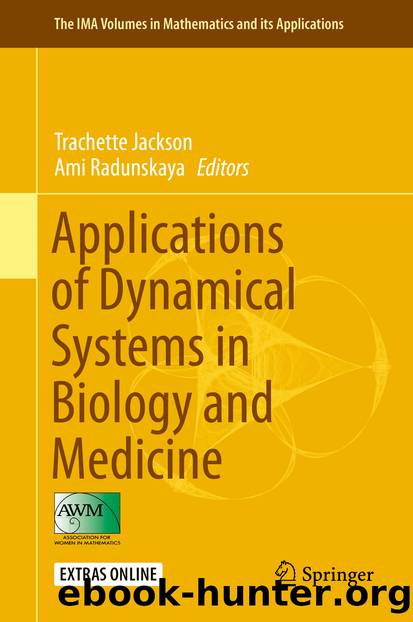Applications of Dynamical Systems in Biology and Medicine by Trachette Jackson & Ami Radunskaya

Author:Trachette Jackson & Ami Radunskaya
Language: eng
Format: epub
Publisher: Springer New York, New York, NY
Our analysis of the phase model predicts that in this same network, two stable 8-cluster solutions exist with phase difference between nearest neighbors (see Table 2). In these solutions, each cluster contains 25 cells: C 0 = { 0, 8, 16, …, 192}, C 1 = { 1, 9, 17, …, 193}, C 2 = { 2, 10, 18, …, 194}, C 3 = { 3, 11, 19, …, 195}, …, C 7 = { 7, 15, 23, …, 199}. For the 8-cluster solution corresponding to , the cluster firing order is {C 0, C 3, C 6, C 1, C 4, C 7, C 2, C 5}. For , the clusters fire in the following order {C 0, C 5, C 2, C 7, C 4, C 1, C 6, C 3}. The phase difference between successively firing clusters is . See Figure 4(b).
There were some cases where the numerically observed stability of n-cluster solutions did not agree with that predicted by the phase model. While the 3-cluster solution was numerically stable in networks with N = 3p cells and single nearest neighbor coupling, with two nearest neighbor coupling, the maximal synaptic conductance g syn had to be weaker (0. 1 instead of 0. 2 mS/cm2) to numerically find these solutions. Additionally, recall that the phase model predicted that the 2-cluster solution is stable for all networks with an even number of neurons and either single or two nearest neighbor coupling. This solution corresponds to the network breaking into two clusters and , with phase difference ψ = π between nearest neighbors. We found this solution numerically in networks with single nearest neighbor coupling and N = 2, …, 200. However, with two nearest neighbor coupling we did not find this solution numerically. Closer consideration of the eigenvalues in this case shows that the stability is weaker, in the sense that the magnitude of the real part of the eigenvalues is smaller. Thus it is possible that the solution has a smaller basin of attraction and is harder to find numerically. Alternatively, the phase model may no longer accurately predict the network behavior as the coupling is too strong. In these networks, a different 2-cluster solution was found when N = 4p in which and . In this solution, the phase difference between every nearest neighbor is not the same. We discuss these 2-cluster solutions in more detail below.
Download
This site does not store any files on its server. We only index and link to content provided by other sites. Please contact the content providers to delete copyright contents if any and email us, we'll remove relevant links or contents immediately.
| Applied | Geometry & Topology |
| History | Infinity |
| Mathematical Analysis | Matrices |
| Number Systems | Popular & Elementary |
| Pure Mathematics | Reference |
| Research | Study & Teaching |
| Transformations | Trigonometry |
Modelling of Convective Heat and Mass Transfer in Rotating Flows by Igor V. Shevchuk(6406)
Weapons of Math Destruction by Cathy O'Neil(6218)
Factfulness: Ten Reasons We're Wrong About the World – and Why Things Are Better Than You Think by Hans Rosling(4713)
A Mind For Numbers: How to Excel at Math and Science (Even If You Flunked Algebra) by Barbara Oakley(3257)
Descartes' Error by Antonio Damasio(3248)
Factfulness_Ten Reasons We're Wrong About the World_and Why Things Are Better Than You Think by Hans Rosling(3216)
TCP IP by Todd Lammle(3155)
Fooled by Randomness: The Hidden Role of Chance in Life and in the Markets by Nassim Nicholas Taleb(3082)
Applied Predictive Modeling by Max Kuhn & Kjell Johnson(3041)
The Tyranny of Metrics by Jerry Z. Muller(3029)
The Book of Numbers by Peter Bentley(2931)
The Great Unknown by Marcus du Sautoy(2662)
Once Upon an Algorithm by Martin Erwig(2623)
Easy Algebra Step-by-Step by Sandra Luna McCune(2604)
Lady Luck by Kristen Ashley(2554)
Police Exams Prep 2018-2019 by Kaplan Test Prep(2516)
Practical Guide To Principal Component Methods in R (Multivariate Analysis Book 2) by Alboukadel Kassambara(2513)
All Things Reconsidered by Bill Thompson III(2371)
Linear Time-Invariant Systems, Behaviors and Modules by Ulrich Oberst & Martin Scheicher & Ingrid Scheicher(2346)
